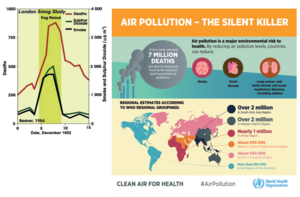Motivation

Right: According to the WHO the worldwide annual death toll due to air pollution is in the range of seven million premature deaths (in: Ambient Air Pollution: A global assessment of exposure and burden of disease. WHO report, 2016).
The World Health Organization WHO states, that air pollution by particulate matter (PM) is the largest environmental health risk in Europe, causing a substantial disease burden. It is estimated that in 2014 more than 90% of the world population lived in places where WHO air quality guidelines were not met, causing more than 3 million premature deaths due to exposure to ambient air pollution and making it the fourth-highest risk factor for death globally. A recent study on the U.S. Medicare population concluded that exposure even below WHO guideline levels to air pollution lead to serious health effects.
However, there is a substantial knowledge gap regarding the drivers and underlying mechanisms of the health effects and, as a result, a lack of data that can be used for burden assessment and mitigation policies. Despite extensive research, it is still unclear which aerosol elements or compound classes cause adverse health effects, what are the prevailing biological mechanisms behind them, and how these effects depend on atmospheric chemistry. The scientific research questions behind this complex problem are highly interdisciplinary and addressing them requires health-, geo- and environmental sciences, engineering, physics, chemistry, biology, statistics, and computing/modeling to work together.
Atmospheric aerosols are complex mixtures of directly emitted (primary) aerosols and those formed in the atmosphere by chemical reactions of gaseous precursors (secondary aerosols). Up to 80% of the fine particulate matter forms through atmospheric chemistry processes, where oxidation of gas-phase precursors form multi-functional condensable products that partition to the particle phase. Changes in atmospheric composition are expected through emission changes from natural and anthropogenic sources that will lead to complex and variable secondary particle composition and exposure. Moreover, a warmer climate enhances wildfire and high pollution events, while changes in atmospheric flows will transport dust into new regions.
The research question of the impact of atmospherically aged emission on health led to the formation of the aeroHEALTH consortium, an international cooperation of the Helmholtz Zentrum München (HMGU, Germany) the Forschungszentrum Jülich (FZJ, Germany), and the Weizmann Institute of Science (WIS, Israel) as well as further associated partners. Unique simulation facilities to study aging at different time scales and simulation complexity (e.g. SAPHIR aerosol chamber, oxidation flow tube reactors) coupled to advanced exposure systems for biological models (air liquid interface exposure units for exposing cell lines, co-culture tissue models, or knockout cell lines as well as invivo models) will be used for studying the health effects of complex aerosols and to elucidate how they change during atmospheric aging. Various exposure mo-dels in combination with state-of-the-art biological investiga-tions (of functional and “omics”-level) will be implemented for deciphering the biological effects. aeroHEALTH establishes a direct link between emission scenarios, chemical composition, atmo-spheric aging and health effects. By combining facilities and expertise, the aeroHEALTH consortium will be enabled to address these complexities on a level that was not possible before. The obtained knowledge will finally be essential for science-based strategies and guidelines for policy makers as well as the development of abatement strategies and technologies.
